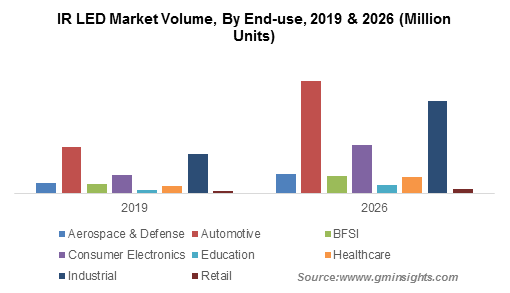Infrared (IR) LED market to witness highly appreciable gains from the consumer electronics sector, global industry to chronicle itself in the billion-dollar business space by 2024
Publisher : Fractovia | Published Date : 2018-09-20Request Sample
The increase in demand for consumer electronics owing to rising disposable income has propelled the overall infrared (IR) LED market, which is characterized by a slew of technological advantages. The unique properties of IR LEDs are useful in remote sensing, surveillance, heating and visual recording, making them an ideal component for application is different end-user segments. The infrared LED industry offers efficient components for remote controlled appliances and nighttime video recording equipment. Moreover, the advent of biometric systems as a security measure in smart home technology and mobile phones has positively influenced the global infrared LED market, which was valued at more than USD 400 million in 2017.
Japan infrared LED market size, by application, 2017 & 2024 (USD Million)

IR LEDs allow the scanning of iris and facial structures which form the basis of modern biometric security systems. The integration of these technologies has enabled companies to offer enhanced home security products comprising of cameras, biometric scanners and IR sensors, representing an evolving segment that is contributing towards the growth of the infrared LED market. Facial recognition cameras installed at appropriate locations help to identify whether the person at home is a family or homeowner, or any one seeking to enter the house is a known or unknown entity. Monitoring and controlling such a technology has become easier with the connectivity of various security components with each other. A gradual increase in the popularity of similar smart home systems will certainly expand the infrared LED market penetration into consumer electronics.
It was reported that in 2015, the global spending on consumer tech had reached nearly USD 955 billion, demonstrating the massive potential for small components such as IR LEDs which add value to a consumer durable. Smartphones are also a prime application for the infrared LED industry, with uses such as remotely controlling electronic appliances, although more recently biometric technology has transformed the dynamics of the mobile phone segment. Facial and iris recognition capabilities are now available in smartphones of several brands such as Samsung, Apple and Xiomi, giving IR LED manufacturers an additional earnings avenue. Advancement in manufacturing technologies have enabled the production of small sized LEDs that save space for other important applications as well, besides serving multiple purposes themselves.
Elaborating further, Lextar Electronics had released a product line of IR LEDs in September 2017, consisting of two IR packages having distinct beam angels. The LEDs with smaller beam angle is suitable for the iris recognition function in the mobile phones while the larger beam angle product can be used for facial recognition. The products have already been adopted by mobile phone companies that offer iris and facial biometric features in their phone, inadvertently propelling infrared LED market share from the consumer electronics sector. Various technology firms have also initiated programs to use IR LEDs in phones for innovative applications, with OSRAM being one of the leading industry players introducing revolutionary LED products.
To elaborate, recently OSRAM launched a new LED product that can be integrated into smartphones to help consumers identify elements within food they are to eat or want to buy. The company claims that users can scan food at home, restaurants or supermarkets with their smartphones and know the content of the food, including fat, sugar, water or proteins. The product applies near-infrared spectroscopy to determine the presence of specific ingredients and their quantity, signifying an innovative approach towards the adoption of the infrared LED industry in electronic products. As mobile technology becomes more sophisticated to offer cutting-edge health monitoring features, the infrared LED market will correspondingly evolve to keep pace with the global demand.
As evident, the infrared LED market provides opportunities for gaining primary healthcare benefits, but the ability of these components to assist in medical therapies also cannot be ignored. Apparently, IR LEDs are being used in blood analysis and endoscopy applications, whereas their utility in therapeutic devices are being explored more rapidly. Studies have proven than IR panels have been applied to improve wound healing process and provide pain relief therapies through heating, as IR LEDs are a heating source that do not dry out air. Larson Electronics, for instance, boasts of an IR LED product designed especially for treatments in the dermatology and neurology domains, with wavelengths suitable to infiltrate human tissues and assist recovery at cell level.
Widespread benefits in the healthcare sector will generate added revenues for the infrared LED industry, supported by the consistent innovations being achieved in healthcare and medical treatment devices. Some of the prominent companies defining the competitive landscape of the infrared LED market are Osram, Raytek Corporation, Epistar, Lite-On Technology, EVERLIGHT and Vishay Intertechnology, Inc.